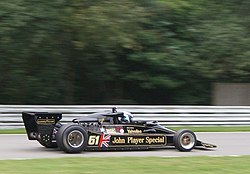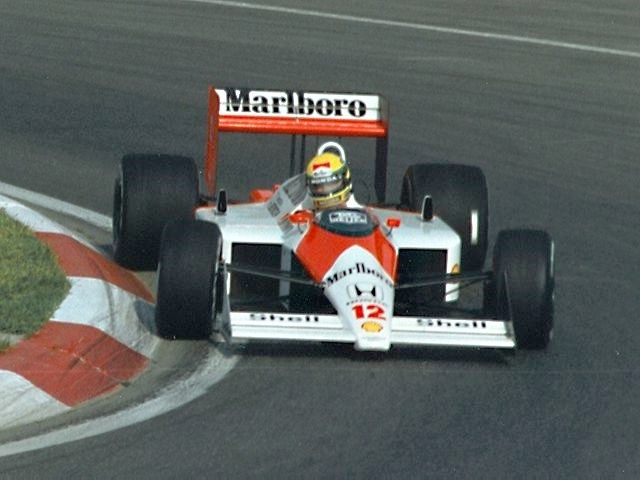Lotus 78 - Since Emerson Fittipaldi's championship season in 1972, the Norfolk outfit had been in the doldrums. A replacement for the Lotus 72, the model 76 was introduced for the start of the 1974 season, however this was not a success. A stopgap chassis, the Lotus 77 was introduced for 1976 whilst Colin Chapman's men worked up the revolutionary 78 model for the following year. Featuring never seen before "ground effect" technology, the car's performance compared to the '77 was like night and day with the team taking five wins during the 1977 season.
Ligier JS9 - After finishing a disappointing sixth in the 1978 World Championship and failing to build on their debut win of the previous year, the French outfit roared out of the blocks by winning the first two rounds of the 1979 season in Argentina and Brazil. The JS9 was the team's first ground effect car and put them right at the front of the action as Lotus suprisingly failed to capitalise on their all conquering title charge of the previous season and reliability blighted Ferrari and Renault early on in the championship. Depailler took a further win for the team in Spain, but thereafter reliability increasingly became an issue for the JS9 and their raw pace advantage was eroded by others, noteably Williams, Ferrari and Renault.
Mclaren MP4/4 - Whilst the Woking outfit's predecessor chassis from 1987, the MP4/3 had taken three victories, the team's 1988 challenger was on a whole different level of performance altogether. Designed primarily in collaboration between Mclaren personnel Steve Nichol and Gordon Murray, the MP4/4 contained significant elements of the design of an earlier Murray chassis, the Brabham BT55. Featuring the overall "lowline" profile of the Brabham, a more effective aerodynamic profile, Honda engines and Alain Prost and Ayrton Senna at the wheel, Mclaren won 15 out of 16 races that season. Indeed they were only denied a clean sweep after Senna tangled with a back marker at Monza in the closing laps of the race.
Williams FW14B - Building on the performance of the FW14 during the second half of 1991, the B spec version of the car for the 1992 season featured active suspension, traction control as well as a more reliable semi automatic gearbox than the one that had caused Williams so many problems the year before. The active suspension in particularly made the car pretty much unbeatable for raw pace and took ten victories from a possible 16 for the team. In fact so good was the FW14B that it's planned successor, the FW15 was not introduced until the beginning of 1993 instead of 1992 as originally intended as it was not felt needed.
Bennetton B194 - During the winter of 1993-94 the talk was of just how many races Senna, Williams and Renault were going to take now that the three strongest forces in the sport had finally become one for the 1994 season. So the early season speed of the Bennetton team came as a suprise to many, even to Senna himself. Perhaps in retrospect though it should not have done. Bennetton had only been running active suspension for half a season and were a lot less dependent on it than Williams had been. The team from Enstone also had their car ready far earlier than Williams and a great deal more testing mileage under their belts as a result. Schumacher won six of the opening eight races and went on to claim the title at the final round in Adelaide.
Mclaren MP4/13 - After losing Honda at the end of 1992 and Senna at the end of 1993, Mclaren had fallen into a comparative slump over the following few years. During this time the Williams team had reasserted their position as the pre eminent team in the sport. A large proportion of their resurgence had been down to the design genius of Adrian Newey. The chief designer had wanted to progress to the role of Technical Director, but found his path blocked at Williams by part owner Patrick Head. Thus Newey moved to Mclaren at the end of the 1997 season and took full advantage of the forthcoming rule changes for the following year when building the MP4/13. The two Mclaren's achieved a front row lock out at the season opener in Melbourne and finished the race having lapped everyone at least once, including the once all conquering Williams team.
Brawn BGP 001 - The Brawn team had been formed out of the ashes of the withdrawal of Honda from the sport at the end of 2008 and the new entity's entry for the 2009 campaign was not confirmed until very late in the day. Despite all this upheaval and the design of the car being compromised by being forced to run with a Mercedes engine instead of the Honda unit it had been designed for, the BGP 001 was blisteringly quick from the outset. The secret was Brawn GP's interpretation of the rules around the design of the car's rear area and resulted in what became known as the "double diffuser". The chassis won six of the opening eight races with Jenson Button at the wheel and a further two later in the year for Rubens Barichello on route to a constructor's and driver's world championship double.








No comments:
Post a Comment